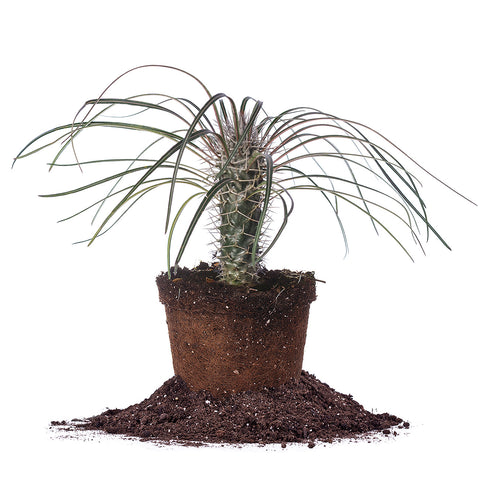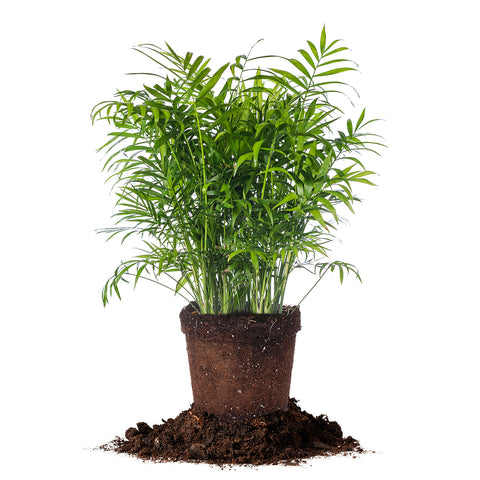How to Plant a Palm Tree
Want to get that tropical look in your yard? Learn how to plant a palm tree.
Best Time to Plant Palm Trees
Mature palm trees with well-developed trunks can be dug and transplanted from the field. Young palms cannot. The roots of young palm trees are not sufficiently developed, so they are typically planted from container-grown stock. Perfect Plants delivers their windmill palm trees (a variety of fan palms) in one and three-gallon containers – perfect for planting out in the home landscape. This Windmill palm against a house is getting full sun and growing in optimum conditions making bright green foliage appear
This Windmill palm against a house is getting full sun and growing in optimum conditions making bright green foliage appear The best time to plant any new tree is in the spring, but trees delivered in containers can be planted any time of year. Still, we recommend setting out your new palm tree in spring or early summer so the warming weather will get it growing right away.
In any case, plant your new palm tree as soon as possible after it arrives. Until then, be sure to keep it in the shade in bright indirect light and keep the root system moist (but not standing in water). Just before planting, however, you should thoroughly soak the root mass in a bucket of water.
Palm Tree Plant Care
 Specially formulated palm fertilizer will nourish your palm plants for 3 months
Specially formulated palm fertilizer will nourish your palm plants for 3 months Palm trees like natural light. Dig a hole twice as wide and a few inches deeper than the root ball. Some experts advocate putting a six inch layer of sand in the bottom of the hole.
Add a handful of slow release palm fertilizer to the center of the hole and work it into the bottom and sides. Remove the root ball from its container and carefully straighten out or cut back any badly coiled roots. Try to minimize potting soil loss around the roots which are delicate and fragile.
Place the top of the root ball in the hole and fill the hole with a mixture of one-half native soil and one-half rotted manure or compost. Water as you backfill, and ensure there are no air pockets. Be sure the palm trunk is no deeper than it was in the original container and that there is nothing exposing the roots!
When the planting hole is filled, build up a berm around the outside of the trunk to retain water over the root zone. Water thoroughly. Apply a six-inch layer of organic mulch over the root zone and beyond for a few feet. Mulch will help protect cold hardy palms during the winter months. Water the tree again. Leaves will turn brown without enough water while the roots establish.
 Windmill Palm, Trachycarpus fortunei
Windmill Palm, Trachycarpus fortunei Palms prefer well draining soil to prevent root rot. Poorly drained soils will hold water and cause the trees root ball to get mushy. If planting in a container, make sure it has drainage holes.
Keep your newly planted palm tree well watered (daily unless it rains) for at least a couple months. After 3-4 months you can apply a slow release fertilizer formulated specifically for palms. This plant food is good for any variety of palm and should only be applied during the active growing season.
Palm trees are our #1 pick for tropical plants that are low maintenance.

The Madagascar Palm Tree is a popular indoor plant choice due to its unique appearance and manageable size. This succulent plant features a thick, spiny trunk and a crown of long, thin, and glossy green leaves. It thrives in bright, indirect light and well-draining soil, and grows up to 6 to 8 feet tall. The Madagascar Palm Tree makes for an intriguing and low-maintenance addition to any indoor space.

The Parlor Palm, scientifically known as Chamaedorea elegans, is a popular houseplant choice due to its elegant appearance and low-maintenance nature. Native to Mexico and Guatemala, this palm species is characterized by its compact growth habit and slender, green leaves. It is often recommended as a great plant for beginners or those new to indoor gardening, as it is not toxic to pets and can thrive in low-light conditions. With its ability to grow quickly while staying small, the Parlor Palm adds a touch of lushness to any indoor space.






















